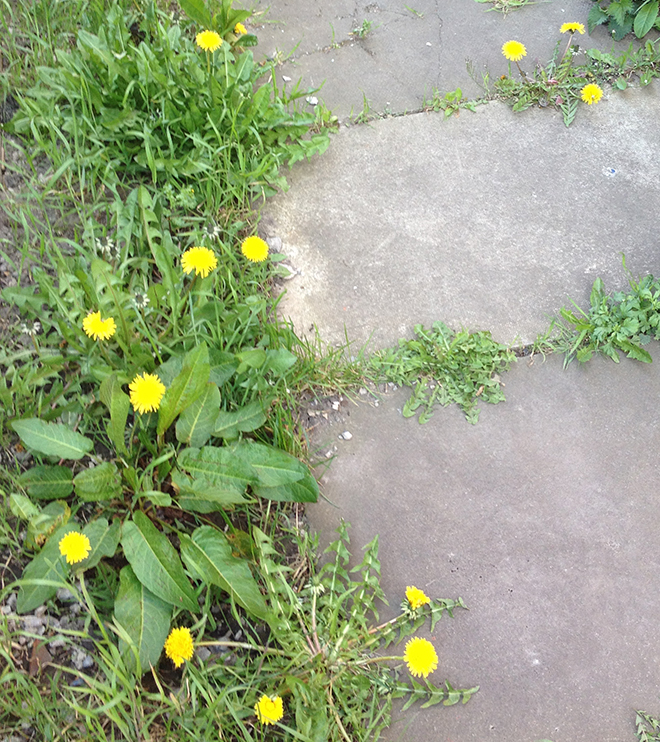Clocks, coffee, salads and the King’s scrofula. Dandelion roots are a winter staple and the whole plant has a surprising amount of uses.
Dandelions (Taraxacum officinale, Compositae) need hardly any introduction with their puffball seed heads or clocks and their brilliant yellow flowers. They herald the Spring and provide a vital early pollinating source for bees and butterflies. They are widespread across Scotland and particularly thrive on mown roadside verges where councils have decimated other wild plants. The name originally came from dent de lion (Welsh: dant y llew) or lion’s tooth as the serrated edges of the leaf do indeed resemble one. Ironically in France they have a different name, pissenlit (Italian: piscialletto), literally wet the bed, paying tribute to the dandelion’s diuretic properties!
The root is a really useful winter vegetable. Young (first-year) roots gathered in the autumn – or the winter if you can find them – can be roasted in an ovenproof dish, with a little olive oil and honey drizzled over them until tender. Or boiled, like carrots. (Change the cooking water halfway through boiling them to reduce the bitterness if you wish.)
Older roots can be chopped into small pieces and roasted in the oven until they go dark-brown and can be snapped with your fingers. When you want to use it, grind the roasted roots in a coffee grinder. The ground dandelion root powder can be used as a decaf hot drink to replace tea or coffee. So it makes a great children’s coffee. Roast dandelion root can also be used to flavour creams and ice-creams giving a coffee-peanut type flavour. (I find that storing the roasted roots for a year also gives them a chocolatey, mocha flavour.) Or mix the powdered roasted root with spices to create an aromatic meat rub.
Fresh dandelion greens are a welcome and vitamin-rich spring vegetable, but inclined to be bitter due to sesquiterpenes found in their milky sap. The acrid sap from the stalk can be applied directly to warts over a few weeks to remove them. In the leaves it is far less concentrated – less bitter in young leaves before the plants flower, and in dandelions growing in wet, shady areas or in long grass. You can also blanch dandelions by tying up, or placing a flowerpot over, the emerging leaves, which makes them less bitter but less nutritious.
In a mixed salad, up to a fifth of lightly chopped dandelion leaves can be added without noticing the bitterness. Instead it adds a piquant note, enhancing the overall taste. When cooking them, if they are young, chop them into 3 cm pieces, add to boiling water and simmer for 5 minutes. If they taste bitter, you may need to drain them, refresh the water and boil them for a further 5 minutes. Then add butter and seasoning as if you were serving spinach. Dandelion leaves are also nice sautéed or wilted in a frying pan with onions or pancetta, or stirred into pasta with ricotta.
Unopened dandelion buds can also be pickled in vinegar or deep fried in batter for a tasty tempura snack.
The vibrant yellow flowers can be used to make a dandelion wine, the whole plant used to make dandelion beer, while the root is combined with burdock to make the traditional fermented Dandelion and Burdock Tonic. This was a non-alcoholic drink that was good for your liver and helped to clear up skin problems – like acne… and the King’s scrofula!
Dandelions contain vitamins A, B, C, D, K, iron, potassium, calcium, manganese and zinc. It is the levels of these that are surprising. Spinach, which we all know is good for us, contains 8,000 I.U. of vitamin A per 100 g whereas dandelion leaf contains 14,000 I.U. – nearly twice as much! Dandelions also have many medicinal uses with their diuretic properties harnessed in detox formulas, skin and liver tonics.
One other interesting aspect of dandelion is that there is not just one dandelion. There are actually over 250 species of lookalikes. If you examine them closely you’ll realise that some differ quite a bit in terms of the cut of their leaf edge or fullness of their flower. For people who are generalists this comes as quite a surprise! It always reminds me what a debt we owe to people who are not neurotypical with the skills and ability to focus on tiny details. Without neurodiversity we would not know that there are over 250 species of this cheery flower, nor would we know so much about the bacteria that inhabit our guts, nor the names of all the stars in the sky!
Please remember that it is illegal to uproot a plant in the U.K. without the permission of the landowner. But few people can resist your offer to do some free weeding for them! In fact, you should share this with anybody who has an abundance of dandelion, as the best way to eradicate a “pest” in the garden is to eat it.
